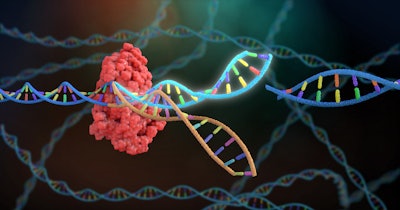
The discovery of a CRISPR enzyme that destroys DNA and RNA in target cells has unlocked opportunities to use molecular scissors in diagnostics and to selectively destroy diseased cells.
In a pair of Nature papers, researchers at Utah State University, Helmholtz Institute for RNA-based Infection Research, U.S.-based biotechnology company Benson Hill, and the University of Texas at Austin describe the structure and function of Cas12a2. Like the better-known Cas9, the nuclease binds and cuts target DNA to shut off a specific gene. The mechanism allows scientists to use the enzymes as molecular scissors.
However, further investigation of Cas12a2 revealed major differences between the enzyme and other nucleases such as Cas9 and the closely related Cas12a. Ryan Jackson, one of the authors of the Nature papers, laid out the findings and their significance for future studies of CRISPR and human health.
“With this new system, known as Cas12a2, we’re seeing a structure and function unlike anything that’s been observed in CRISPR systems to date,” Jackson, assistant professor in Utah State’s Department of Chemistry and Biochemistry, said in a statement. “The Cas12a2 protein undergoes major conformational changes upon binding to RNA that opens an indiscriminate active site for DNA destruction. Cas12a2 destroys the DNA and RNA in target cells, causing them to go senescent.”
In theory, the destructive capabilities of Cas12a2 could open up therapeutic applications. Malignant and infected cells are genetically different from their healthy counterparts. If Cas12a2 can use those genetic differences to identify diseased cells, it could selectively destroy malignant and infected cells without harming healthy tissue.
Years of work stand between researchers and the realization of that vision, but the field now has a new understanding of the Cas12a2 nuclease and how it works. Like other Cas nucleases, Cas12a2 recognizes and cleaves invasive RNA. The difference is that Cas12a2 can also damage other DNA and RNA molecules found inside cells. That collateral damage impairs cell growth and limits the spread of the infection.
Using cryo-electron microscopy, Jackson and his collaborators showed the RNA-triggered degradation of single-stranded RNA, single-stranded DNA, and double-stranded DNA by CRISPR-Cas12a2. After binding to its RNA target, Cas12a2 undergoes major structural changes that create an exposed cleft in the nuclease. The exposed cleft can shred any nucleic acid it encounters.
The degradation process results in a naturally occurring defensive strategy called abortive infection. The researchers have generated early evidence that Cas12a2 can be used for molecular diagnostics and direct detection of RNA biomarkers.



















